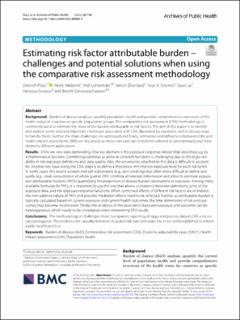| dc.description.abstract | Background
Burden of disease analyses quantify population health and provide comprehensive overviews of the health status of countries or specific population groups. The comparative risk assessment (CRA) methodology is commonly used to estimate the share of the burden attributable to risk factors. The aim of this paper is to identify and address some selected important challenges associated with CRA, illustrated by examples, and to discuss ways to handle them. Further, the main challenges are addressed and finally, similarities and differences between CRA and health impact assessments (HIA) are discussed, as these concepts are sometimes referred to synonymously but have distinctly different applications.
Results
CRAs are very data demanding. One key element is the exposure-response relationship described e.g. by a mathematical function. Combining estimates to arrive at coherent functions is challenging due to the large variability in risk exposure definitions and data quality. Also, the uncertainty attached to this data is difficult to account for. Another key issue along the CRA-steps is to define a theoretical minimal risk exposure level for each risk factor. In some cases, this level is evident and self-explanatory (e.g., zero smoking), but often more difficult to define and justify (e.g., ideal consumption of whole grains). CRA combine all relevant information and allow to estimate population attributable fractions (PAFs) quantifying the proportion of disease burden attributable to exposure. Among many available formulae for PAFs, it is important to use the one that allows consistency between definitions, units of the exposure data, and the exposure response functions. When combined effects of different risk factors are of interest, the non-additive nature of PAFs and possible mediation effects need to be reflected. Further, as attributable burden is typically calculated based on current exposure and current health outcomes, the time dimensions of risk and outcomes may become inconsistent. Finally, the evidence of the association between exposure and outcome can be heterogeneous which needs to be considered when interpreting CRA results.
Conclusions
The methodological challenges make transparent reporting of input and process data in CRA a necessary prerequisite. The evidence for causality between included risk-outcome pairs has to be well established to inform public health practice. | en_US |

